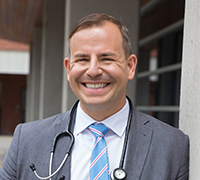
Dr. Ed Kucharski
Chief Medical Officer at Casey House
Highly effective new drug therapies for treatment and prevention empower individuals and communities affected by HIV
In June 1981, the very first cases of acquired immunodeficiency syndrome (AIDS) were reported in the United States. What followed over the last four decades has been filled with heartache and hope. Today, people with HIV can live dynamic lives because of the great advancements in treatment and prevention.
Milestones in HIV worth celebrating
There have been some incredible milestones along the way, points out Dr. Ed Kucharski, chief medical officer, at Toronto’s Casey House (founded in 1988), to help those diagnosed with HIV and AIDS. “In the early days, it was a huge accomplishment to isolate the virus that caused HIV,” he says. “Then in the 1990s, other new antiretrovirals revolutionized treatment. At that time, there were only a couple of drugs available and they weren’t enough to control AIDS. Then in the late 1990s and early 2000s, prevention became a focus pioneered by Vancouver doctor Julio Montaner and his Treatment as Prevention (TasP) initiative. Then as we moved into this decade, we’re getting more into PrEP (pre-exposure prophylaxis) so people who don’t have HIV but are at risk of getting it can take a medication that reduces their risk in a very effective way. Now, the concept of Undetectable = Untransmittable (U=U) is a big milestone, too.”
Dr. Montaner’s scientific work is the foundation of the U=U, which has been embraced internationally. The concept is based on studies that showed people living with HIV who have an undetectable amount of virus in their blood because they’re being treated effectively cannot transmit the virus to others. In couples where one partner has HIV and the other does not, there is ongoing fear – both of getting the virus and passing it on to someone. “Now knowing that if the HIV positive person takes their medication regularly, they can’t transmit the virus, which is freeing and destigmatizing,” says Dr. Kucharski. “Whether it’s PrEP, U=U, or TasP, these strategies are very empowering because things are things one can do to not only improve their health, but also protect the community as well.”
Fighting the stigma of HIV
There is still much work to be done around destigmatizing HIV. Research has shown that a good number of Canadians would not want to eat a meal with someone who has HIV. “There is still a stigma in the general population that people can still get HIV through very safe activities,” he says. “Let alone having sex or being involved in a more intimate way. I think U=U will help reduce those very wrong and old perceptions about contracting HIV.”
Building awareness and education is key. While U=U may be known among the LGBTQ+ community, outside of it, the average Canadian may not know about the advancements in treatment and prevention. The early days of HIV in the 1980s and ’90s were a scary time when AIDS was almost uniformly fatal. That ancient history has left an impression that has cast a long shadow over the current reality where those with HIV can live long and fruitful lives with treatment. “The story of HIV is both a huge tragedy in many different ways and a triumph of modern medicine,” notes Dr. Kucharski.
Drug therapies have fewer side effects than those 30 and 40 years ago. Those with HIV can take a single pill daily as part of their treatment, not so different than medications taken for other conditions like high blood pressure or depression, and live well with HIV.
“It has been an incredible journey filled with tears of sadness and joy,” says Dr. Kucharski. “There have been some truly remarkable things that have happened along the way.”


